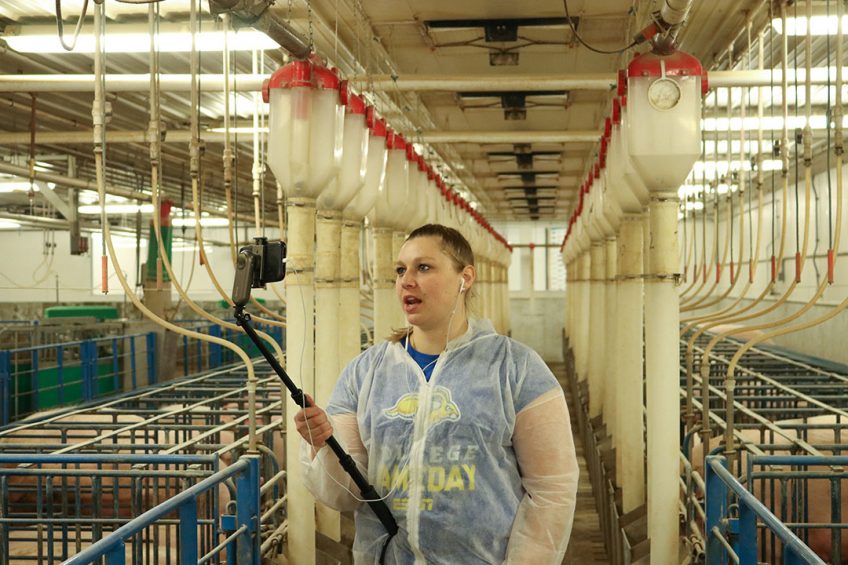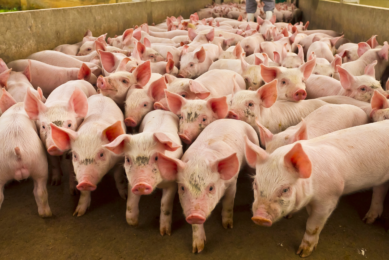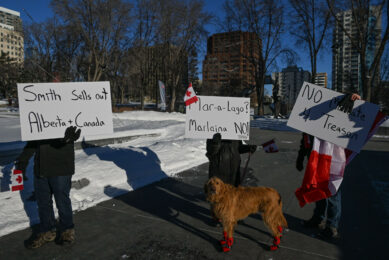Farm visit: Opening new avenues for pig promotion

Demystifying the pork industry – that is the goal of the virtual tours through the swine education and research facility of South Dakota State University (SDSU). The research farm is the only academic facility in the US to offer a live look behind the scenes to a wide range of audiences. Since Covid-19, demand for the visits has soared. Time for Pig Progress to take a look as well.
“How many piglets does a sow have each time?”
“What happens when a sow has more piglets than she has nipples?”
“How many litters does a sow have per year?”
To anyone in the swine business these questions will probably sound familiar. These are typical for outsiders who are generally oblivious to what goes on inside swine barns. And that is exactly why these questions are placed prominently at the beginning of this article. The questions were asked live to Katelyn Zeamer, graduate research assistant in Animal Sciences at SDSU, while she was standing inside a farrowing barn filming herself in a promotional video for the US Pork Checkoff.
Virtual visitors
At SDSU, virtual visitors are welcome to come and take a look inside the facilities at the university’s Swine Education and Research Unit, located in Brookings, SD. Whether they hail from Los Angeles or New York and whether they work in agriculture or not, they are all welcome to join for a ‘virtual barn tour’.
Visitors come from all over the United States. They can be thousands of kilometres away from the barn, yet for 10 or 15 minutes, they can suddenly enter the world of sows, piglets, lactation pens, phase feeding and corn and soy diets – elements that are normally only vaguely understood if not completely unknown to visitors. First of all – what will they see?

The university facility
The animal science faculty at SDSU has traditionally focused on animal nutrition and meat science research. For many years, the university has had swine farm facilities for teaching and (external) research. In 2011, an entirely new swine research facility was approved, as the previous facilities had become outdated. A new facility, worth US$ 7.4 million, and paid for by gifts from pork producers and allied industry partners from over 125 companies in agriculture, was eventually opened in October 2016.
2 barns on 2 sites
The research unit consists of 2 barns on 2 sites. The first 2 barns are about 400m from the SDSU campus. Together, these 2 are a 150-sow farrow-to-finish operation. The first barn houses the breeding animals in 5 groups of 30. Gestating sows are kept in both individual stalls as well as pens, to be able to show both systems. In lactation, the pens are equipped with Electronic Sow Feeding systems by Gestal. The second house is the wean-to-finish barn. It has a capacity for 1,200 animals and is where the piglets go after coming out of the breeding barn at 21 days of age. Both nursery and finishing trials are done here. Pigs go to the Smithfield slaughter plant in Sioux Falls, SD, when they reach 285lbs (129kg).

Third barn
A third barn is located 18km south of Brookings. It is a commercial-style grow-finish barn, again for 1,200 finisher pigs, with 25 pigs/pen. These animals hail from one of the larger pork producers in the US. Basically, the unit is a contract finisher site adapted to do production research; the money paid by this producer covers the costs at this location, explains Professor Bob Thaler, extension swine specialist at SDSU. This location is mostly used to do large-scale feed studies. It is equipped with scaled pens and a computerised feeding system, allowing for six different diets to be tested at the same time.

Profile
Name: Prof Robert Thaler.
Location: Brookings, SD, United States.
Farm: The SDSU Swine Education and Research Unit consists of three barns on two sites, all dedicated to education and research. The onsite facility is a 150-sow farrow-to-finish unit with, directly adjacent, a 1,200-head capacity grow-finisher unit. In addition, there is also a commercial style offsite grow-finisher unit with another 1,200 places. The research facility runs roughly 20–25 trials per year. Apart from a swine unit, the university’s College of Agriculture, Food and Environmental Sciences also has a new cow-calf unit, in addition to an existing dairy unit, sheep unit and beef feedlot.
The farm sites are populated with commercial breeds, with the females being of PIC origin and the Duroc semen being supplied by Compart, based in Minnesota. As would be expected under US conditions, meals are mostly based on corn-soybean meal, supplemented with some Distiller’s Dried Grains and Solubles (DDGS). For veterinary consultation, SDSU cooperates with Pipestone Veterinary Clinic. According to protocols, a shower-in, shower-out procedure is necessary and a 48-hour downtime is mandatory before access to the swine facilities is granted. For those visitors who would like only to view the animals, but not necessarily go near them, the sow barn has also been equipped with a viewing gallery.
A National Pork Board policy
The majority of visitors, however, do not physically visit the farm these days but access it from anywhere using a screen and headphones. Typically these tours form part of a larger programme including other speakers and a presenter. They last for about ten minutes, and they have roughly 30–40 people at a time.

The road towards that concept has been a long one. The initiative to let swine industry professionals talk about their work has existed for more than 15 years and was set up by the US National Pork Board as “Operation Main Street” (OMS). The aim? Helping pork producers and veterinarians get better trained to tell their story – simply to go out and share the message in presentations to improve the image of pig farming.
For that approach to be successful, the National Pork Board is relying on speakers bureau Eidson & Partners, based in Kansas City, KS, to train the swine professionals to get their message across. The bureau’s owner Al Eidson explains, “The whole idea is to take people in the industry, train them and deploy them. And of course, when Covid-19 was declared last March, a national emergency in this country, the whole programme overnight flipped over and became virtual.… Covid-19 made it acceptable to do presentations and tours remotely. It quickly normalised.”

Video about showering
The concept of virtual tours emerged several years before Covid-19 when SDSU student Maddie Schaefer Hokanson did a video about showering into a swine unit using the new barn. That sparked the idea of having her do live tours with her phone, Prof Thaler explains. “The programme just snowballed after that.” Plus, as Eidson says, “It is very hard with a PowerPoint to convey what happens in a barn. You can do it with video and that helps. Our plan was to train undergraduate students, principally in animal science, as tour guides and do live virtual tours of the farrowing barn. And it started as a great experiment. We had no idea what would come out of it.”
Benefits
Prof Thaler explains there are several benefits for SDSU to be part of the virtual tours. “First, one of president Barry Dunn’s visions for the new swine unit was to ‘demystify’ pork production. By utilising technology, we open the doors of modern pork production literally to the whole world. Secondly, pork producers across the region invested financially in our unit, and by helping educate the non-ag population about how we stress animal well-being and animal husbandry in everything we do, it will hopefully make it easier for responsibly placed swine barns to be built. Finally, it is an excellent way to develop leadership and communication skills in our students.”
The first online visit started on 7 December 2017 – and gradually the concept drew more visits. In 2019, the year prior to Covid-19, there was 1 virtual tour per week on average – and since the pandemic, the tours have become more frequent for targeted audiences. Currently, there are 2 or 3 per week, each attracting 30–40 attendees. Early in 2021, the 250th virtual tour was approaching fast.

The presenters at the SDSU swine farm
At SDSU, roughly 6 tour guides are available to take their audiences on a tour through a barn. The majority of tour guides are women. Prof Thaler says, “Most of the students grew up on pig farms themselves. It is an area they are passionate about and they love to tell the story and help the pork industry.”
Eidson adds, “What we look for is students who are intently engaged in their career in agricultural science. We want serious students who will take this seriously. And they see it as a chance to learn. The experience as a tour guide is viewed as a solid addition to a student’s resume.”
The tour guides are assisted by a moderator at a distance, located in Kansas, who is in the middle between the tour guide, the programme presenter and audience. All the hardware the guides need is a mobile phone and a gimbal stabiliser. Eidson says, “We’ve tried a lot of different things and the most success we had in terms of connectivity and the best resolution is the current generation iPhone or Android phone and fantastic cell coverage near the barn. We go directly from the barn all through the internet. After several hundred presentations, I can’t think of one where we had catastrophic connection problems.”

Eidson adds, “When we first started this, someone had the idea: Isn’t a hog barn going to be very noisy? Don’t we need noise cancelling microphones? And then the first time we walked in the barn and found all these content animals. The sound of a content sow tells a huge story. So we learnt that the ambient sound in the barn tells its own story, because it’s quiet and it’s orderly.”
The virtual tours are carried out in the two barns near the campus, as the major limitation is wifi access, Prof Thaler notes. Yet the farrowing/lactating barn is most in demand anyway. He says. “Everybody wants to see baby pigs.”
The audience watching the tour
The audience attending a virtual tour can be diverse, with the majority of attendees never even having considered visiting a pig farm before. Usually, it’s the National Pork Board taking the initiative to set up virtual tours by reaching out to various audiences such as human dietitians, members of the medical sector such as nurses (because of their interest in nutrition and antibiotics) and people from education – from high schools, community colleges and even schools of veterinary medicine. Eidson notes that in 2020 many questions were related to Covid-19 and how that had impacted food supply.
Prof Thaler says, “With Zoom, suddenly a programme that had been ‘in person’ in largely 12 states generally in the Midwest and North Carolina, now has a national footprint. And we have reached audiences on both coasts. The further away an audience is from the Midwest, not surprisingly, the less the audience is even aware of pork production. It’s like a different country to them, to see how these animals are raised.”
Responses have been very good, both Prof Thaler and Eidson explain, as they often use surveys after the virtual tours. “We can see opinions change; we ask them before and after and we see a shift of 20–30% towards a positive view of pork production.”
And obviously, the audience learns a thing or 2. If they joined Katelyn Zeamer’s tour, they will surely never forget the answers 12-14, foster sows and 2½.
South Dakota: Many animals, few people
A relatively large portion of the population in South Dakota works in agriculture. With an area of almost 200,000 km2, South Dakota is about the size of Belarus but has only 885,000 inhabitants – an average of 4.42 people per km2, making it the fifth least populous state in the US. In the west of the state, mountainous ranges and higher altitudes dominate the landscape; most pigs (2.3 million) and beef cattle (4 million) are kept on the eastern border, where the state borders both Minnesota and Iowa. That is also the location of Brookings, where the SDSU campus is found. Not surprisingly, the university’s curriculum reflects the state’s emphasis on agriculture.











